Whiskey Art: Capturing the Significance of Distillation in Every Brushstroke
Wiki Article
Catching the Essence of Bourbon Art With Unique Aesthetic Representations and Designs
The art of bourbon extends past the liquid itself, materializing via a variety of visual representations that envelop its storied heritage and craftsmanship. What stays to be revealed is just how these advancing styles show not just the bourbon itself yet likewise the altering landscape of imaginative interpretation. Limited Edition.The Background of Whiskey Art

As scotch manufacturing spread, so too did the need to raise its experience via art. From the elaborate inscriptions on early casks to the elaborate tags of modern-day bottles, each aspect mirrors a distinct imaginative vision, working as an aesthetic story of the whiskey's heritage.
In the 18th and 19th centuries, the surge of the commercial transformation additionally enhanced whiskey art, causing cutting-edge packaging and advertising and marketing that captured consumer interest. Artists and developers started try out appearances, imbuing whiskey-related images with symbolic meanings that communicated concepts of practice, workmanship, and area.
Today, bourbon art remains to advance, mixing traditional methods with contemporary art types. Limited Edition. This continuous discussion between the spirit and its graph highlights the enduring bond between whiskey and society, enhancing the general experience for fanatics worldwide
Iconic Container Styles
While numerous variables add to the attraction of bourbon, renowned bottle layouts play an essential role in forming customer perception and enhancing the overall experience. The visual discussion of scotch bottles is not merely an aesthetic consideration; it functions as a bridge in between the product and the consumer, evoking emotions and establishing assumptions.Unique shapes, products, and closures can boost a whiskey brand name's identification, making it promptly recognizable on congested racks. As an example, the traditional Glenfiddich container, with its elegant conical silhouette, conveys a feeling of tradition and workmanship, while the bold, contemporary layout of the Balvenie container reflects innovation and refinement. The use of tinted glass or distinct appearances can suggest the high quality and personality of the whiskey within.
Legendary styles frequently include elements of cultural heritage, signifying the brand's background and link to its roots. Brand Names like Jack Daniel's make use of a simple, durable style that reverberates with its American bourbon heritage. Ultimately, the effect of container layout prolongs beyond simple functionality; it envelops the significance of the brand, inviting consumers to discover and delight in the abundant tapestry of whiskey culture.
Label Art Work and Branding
Container designs commonly establish the phase wherefore consumers can expect, however label art work and branding play a similarly substantial duty in communicating a whiskey's identity. The label functions as the first point of contact between the consumer and the item, encapsulating the essence of the whiskey within its visual aspects.Efficient label artwork combines images, shade, and typography to create a story that reverberates with the brand's heritage and target market. For circumstances, a tag featuring complex illustrations and classic font styles might stimulate a sense of custom and workmanship, appealing to aficionados. On the other hand, vibrant colors and modern style elements might bring in a more youthful market seeking advancement and excitement.

Digital Photography and Visual Storytelling
Catching the essence of scotch via photography and visual storytelling is an art type that boosts the brand name experience. This tool transcends mere item representation, diving into the complex stories that border each container. By employing compelling images, professional photographers can stimulate feelings that reverberate with customers, inevitably forging a deeper connection to the scotch brand name.Aesthetic narration in bourbon photography frequently makes use of rich appearances, lights, and make-up to highlight the distinct qualities of the spirit. The interplay of light and shadow can highlight the amber colors of whiskey, while the option of background aspects-- such as rustic barrels or stylish glasses-- can strengthen the brand's heritage or lifestyle associations.
Furthermore, capturing the ritualistic facets of whiskey usage, from the pouring to the tasting, welcomes visitors right into a sensory experience, enabling them to envision the tastes and scents that await. Each great site photograph not just showcases the item however likewise narrates of workmanship, custom, and the moments that bourbon can enhance - Limited Edition. Hence, digital photography ends up being a powerful device in verbalizing the identification of bourbon brand names, positioning you can try this out them within the broader social landscape
Emerging Trends in Bourbon Art
The development of whiskey art is increasingly shaped by contemporary trends that mirror broader social changes and customer preferences. This shift not just highlights the significance of sustainability however likewise boosts the narrative bordering bourbon production.In addition, digital art has actually surged in popularity, enabling innovative depictions of bourbon. Artists are leveraging modern technology to craft immersive experiences, such as augmented truth installments that engage audiences and supply a deeper understanding of scotch's social value. This trend likewise encompasses social media sites platforms, where aesthetically striking web content amasses attention and promotes neighborhood amongst fanatics.
Moreover, cooperations in between whiskey brands and artists are becoming much more commonplace. These partnerships produce limited-edition product packaging designs and exclusive artworks that celebrate both the craftsmanship of scotch and the imagination of artists. As scotch art remains to evolve, these arising fads will certainly shape its future, promoting other a dynamic junction of society, sustainability, and modern technology within the bourbon area.
Verdict
Finally, the art of bourbon includes a varied variety of aesthetic representations that reflect its rich heritage and workmanship. From renowned bottle layouts and complex tag artwork to compelling digital photography, each element adds to a broader story that boosts the consumer's experience. As emerging fads, such as electronic art and sustainability, proceed to shape this artistic landscape, the multifaceted identification of scotch remains a sustaining resource of social connection and expedition.

In final thought, the art of scotch includes a diverse array of aesthetic depictions that mirror its abundant heritage and workmanship.
Report this wiki page